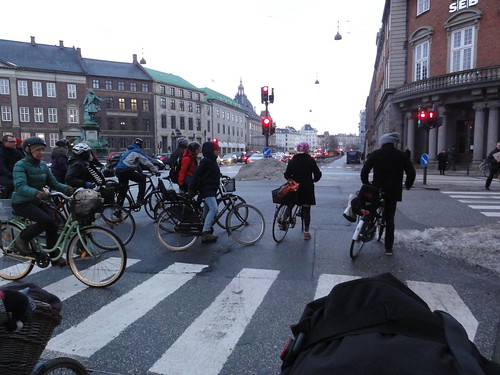
| ♫♪Yes, there used to be a painted bike lane right here. ♫ (with apologies to Joe Raposo) |
This time period appears again and again in the scriptures of various religions, but especially in the christian bible (which may have inherited it from paganism) where it, amongst other things, measures the period of Lent. The day of this posting will mark the reaching of Forty Days and Forty Nights by an example of something far less spiritual but very detrimental to the realization of the goal of Copenhagenization. And this is an important topic to address and discuss as North America begins to see an explosion in the addition of bicycle infrastructure to its "Complete Streets" where cars are no longer allowed to totally dominate as they not long ago did.
Paint is not enough!
In most of the pictures throughout this post, you see the results of a contractor (in the United States this is usually the firm that submitted the lowest bid to do the job) working on underground utilities and the damage done to a paint-only bicycle infrastructure project.
| Was once quite a rare sight on this street. |
The street in question used to be a four-lane "facility" with curbside parking on each side, no turn lanes and no accommodations for bicycles what-so-ever. The speed limit was routinely being exceeded by motor vehicles and this street was easily a candidate for at least a five miles-per-hour increase thanks to the incredibly biased method of setting speed limits known as The 85th-Percentile. Indeed the street has a higher speed limit when it crosses over into the adjoining city because there it passes by some formally industrial areas.
 |
| Source: NYCDOT Allerton Avenue project |
| But of course, the cyclist pictogram is wearing a helmet. |
(There was actually a period in time after the USA's Manual on Uniform Traffic Control Devices (MUTCD) was changed to reflect this "newer" standard when I witnessed crews actually being dispatched to paint the helmet onto already extant pictograms around the city I lived in at the time!)
| Now a very popular route. |
The road diet has been successful. First and foremost, this street did not need all the capacity that having two lanes in each direction was providing; It simply did not have the motor vehicle volume. While this is one of a longer street street in surrounding area, it does terminate in the city in which the photos are taken and so does not function as a long-distance alternative to the overcrowded "freeway" system, which many motorists in Southern California are now chosing to avoid by using these more predictable "surface streets". The street now has a center lane for turns which has two obvious benefits. 1)Motorists needing to take a left hand turn now can sit in a demarcated refuge awaiting their opportunity to turn, and do so without blocking the other motorists who happened to be behind them, in the same lane, under the old layout. 2)When crossing oncoming traffic, the motorists only have one lane of on-coming motor traffic and therefore less oncoming vehicles to look through or around (for cyclists) to make the judgement on whether it is safe or not to complete the turn.
 |
| Copen Hangnam-style! (photo by Steven Vance) |
Finally the center lane is almost always empty except for those aforementioned left-hand turning motorists, and it can be quickly vacated by those in it either by completing the intended turn or re-merging into their own lane of travel. This means that the roadway effectively always has a way to permit emergency vehicles to pass less hindered than they would be when the "four-lane" street existed, especially if, for some reason, that old street layout was full of motorists. Which is a good thing since there is at least one fire station nearby and, as is typical of public safety resources management in the USA, it usually dispatches a full size fire truck along with what the rest of the world calls a "crash-car" (except it is a pick-up truck like the one from the TV Show "Emergency!") to almost every call, regardless of need. That center-lane creation is an important selling point because increasingly, at least in the United States, it is the Public Safety profession who object to or intervene to stop traffic-calming an bicycle-accommodating modifications of infrastructure.
So in the end cyclists ended up with two painted bike lanes on a street that is useful to many and is staying at the posted speed limit . Which brings us back to our contractor-created "scar".
| Good thing no vehicles are parked here today! |
| Savvy SUV-driver "taking the lane"? |
| Defaced painted crosswalk. |
 |
| Richmond |
 |
| Long Beach (photo by Waltarrrrr) |
 |
| Missoula (photo by Brett VA) |




